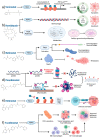Emerging Role of Epigenetic Modifiers in Breast Cancer Pathogenesis and Therapeutic Response
- PMID: 37568822
- PMCID: PMC10417282
- DOI: 10.3390/cancers15154005
Emerging Role of Epigenetic Modifiers in Breast Cancer Pathogenesis and Therapeutic Response
Abstract
Breast cancer pathogenesis, treatment, and patient outcomes are shaped by tumor-intrinsic genomic alterations that divide breast tumors into molecular subtypes. These molecular subtypes often dictate viable therapeutic interventions and, ultimately, patient outcomes. However, heterogeneity in therapeutic response may be a result of underlying epigenetic features that may further stratify breast cancer patient outcomes. In this review, we examine non-genetic mechanisms that drive functional changes to chromatin in breast cancer to contribute to cell and tumor fitness and highlight how epigenetic activity may inform the therapeutic response. We conclude by providing perspectives on the future of therapeutic targeting of epigenetic enzymes, an approach that holds untapped potential to improve breast cancer patient outcomes.
Keywords: HAT; HDAC; breast cancer; chromatin modification; epigenetics; histone acetylation; histone methylation.
Conflict of interest statement
The authors declare no conflict of interest.
Figures


References
-
- Orrantia-Borunda E., Anchondo-Nunez P., Acuna-Aguilar L.E., Gomez-Valles F.O., Ramirez-Valdespino C.A. Subtypes of Breast Cancer. In: Mayrovitz H.N., editor. Breast Cancer. Exon Publications; Brisbane, Australia: 2022. - PubMed
Publication types
Grants and funding
LinkOut - more resources
Full Text Sources

